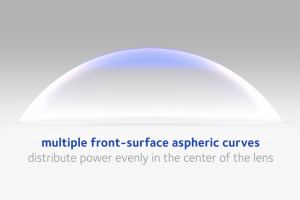
Many differences exist between brands of contact lenses which impact lens optics. The optics of the contact lens is determined by several factors including lens material1 and design2. Optics is the way in which the refraction of light is managed to maximize vision for the contact lens wearer3. Contact lenses with aspheric optics may provide enhanced vision for many wearers.
What are Aspheric Optics?
Regular spherical contact lenses have an even curvature across the entire lens surface; in contrast, aspheric lenses have varying curvatures across the surface changing from lens center to lens edge. Aspheric lenses are used to minimize optical aberrations within the human eye4. Parts of the eye including the tear film, cornea, and crystalline lens can induce aberrations. Contact lenses deliberately induce a level of aberration in the lens that is inversely equal to the amount of natural spherical aberration inherent in the eye to help give clear, crisp and sharp vision3.
Multifocal Lens Wearers
Lens design and the patient’s pupil size are key to multifocal success. The Biofinity Multifocal has a center-distance (D) lens, which transitions through an aspheric intermediate to an outer near zone for the dominant eye. A center-near (N) lens which transitions through an aspheric intermediate to a spherical peripheral distance zone, is placed on the nondominant eye7. When compared with monovision, multifocal contact lens correction provides great vision without compromising depth perception, with continuous adaptation over the first 15 days of wear8.
Computer Users
Biofinity Energys® and MyDay Energys® are designed for digital device users. DigitalBoost™ technology is an innovative single vision aspheric lens design that delivers a +0.3D digital boost, which helps reduce eye tiredness associated with digital eye strain. Study data demonstrates that devices users have a smaller change in accommodative micro-fluctuations (AMF) when wearing this DigitalBoost™ technology, suggesting reduced ciliary muscle stress when reading on a smartphone or other devices at a close distance9.
Which CooperVision® Lenses are Available with Aspheric Optics?
The CooperVision® portfolio of monthly, bi-weekly, and daily lenses are designed with aspheric optics. The Aberration Neutralizing System™ utilizes aspheric optics to neutralize the aberrations from the eye in the Biofinity®, Avaira Vitality™ and MyDay® families. clariti® 1 day contact lenses also offer an aspheric optical design.
Biofinity® & Biofinity® XR
The Biofinity® family of lenses are monthly replacement lenses designed with aspheric optics and combined with Aquaform® Technology to gives incredible end of day comfort for your patients. Biofinity® is the most prescribed monthly replacement on the market10 and will fit almost every patient with over 240,000 unique prescriptions11,12.
Avaira Vitality™
Avaira Vitality™ lenses are highly breathable, bi-weekly replacement lenses designed with the same Aberration Neutralizing System™ as the Biofinity® family. The technology of a Avaira Vitality™ retains the lens surface moist all day, but also blocks transmission of 90% of UVA and 99% of UVB light*.
MyDay®
MyDay® daily disposable are designed with the same Aberration Neutralizing System™ to provide optimal vision combined with UV blocking* and incredible comfort all day long. The MyDay® daily disposable is available in sphere, toric, and multifocal options.
clariti® 1 day
clariti® 1 day contact lenses also offer aspheric optics and provide silicone hydrogel at a comparable price to some hydrogel lenses13†. In addition, clariti® 1 day contact lenses feature high water content (56%), UVA and UVB blocker*, and a low modulus of 0.5 MPa, comparable with other hydrogel lenses. The clariti family also offers sphere, toric and multifocal options and is an ideal entry-level contact lens for new wearers14.
Contact lenses with aspherical optics can be extremely beneficial for subsets of your patients. By recommending a CooperVision® lens, you can be confident you are offering options in support of visual acuity, lens comfort, and eye health ‡.








